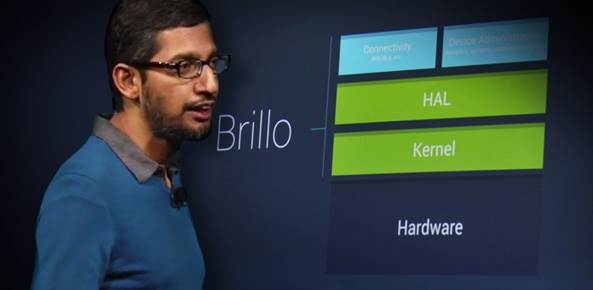Just five years from now, our world will be home to more than 50 billion connected devices, according to Cisco’s data on the Internet of Things. Enabling people to communicate with and control all those devices will require a universal, cross-platform operating system of some kind, which is why Google is developing something called “Project Brillo.”
Senior Vice President of Products Sundar Pichai (pictured) outlined the broad brush strokes of Project Brillo during his opening keynote Thursday at the Google I/O 2015 developers conference in San Francisco. Brillo is a “polished-down” version of Android that will be able to manage a wide range of connected devices in the fast-developing IoT environment, he said. In addition to offering broad-based support and easy-to-manage security, Brillo can be controlled from a central management console, Pichai said.
Along with Brillo, Pichai also unveiled Weave, a communications layer that will allow IoT devices to actually “talk” with one another. A developer preview of Brillo is due out in the third quarter of this year, while Weave is set to roll out sometime in the fourth quarter.
‘Taking a Stab at Standardization’
We reached out to Raul Castanon-Martinez, senior analyst for enterprise mobility and cloud at 451 Research, to learn more about his initial reaction to Project Brillo’s implications. Castanon-Martinez is in San Francisco attending I/O 2015, and was in the audience during Pichai’s keynote.
“The main thing in my opinion is that . . . Google is taking a stab at standardization,” he said. As a spinoff from Android, Brillo will “allow seamless integration for developers working across devices and the IoT,” he added.
Brillo’s impact is likely to be felt first in the consumer IoT market, which includes things like the connected home (Google owns Nest, the smart-thermostat company) and wearables, Castanon-Martinez said. However, it will also apply to the industrial IoT.
More Connected Devices than People
“An important element is the integration with Google Now for voice recognition using natural language understanding, as well as gestures,” Castanon-Martinez noted. “This will allow users to control connected devices using the capabilities of their smartphone.” Brillo is a “key milestone because Google is not starting from square one, but rather leveraging its existing Android footprint and developer base for the IoT,” he said.
In other words, Google is building not just an IoT operating system but “an ecosystem that ties everything together: mobile devices, IoT, interconnectivity and a common language. This is an important step towards standardization, which until now remains a challenge for the adoption of IoT,” Castanon-Martinez said.
Weave will also form an important building block in that ecosystem, as Pichai said it will include a certification program for cross-platform compatibility, ensuring that a Weave-certified device can work together with any other Weave-certified device.
The Internet of Things includes any sensor, smartphone, smart appliance or other device that can communicate and share data with other networked people and devices, according to Cisco. The numbers of these types of devices have grown rapidly in just a few years, to the point that there are now 1.5 connected, smart devices for every person on Earth.







![[Infographic] Why Samsung’s AI TV Is Fit To Upscale Everyday](https://loginby.com/itnews/wp-content/uploads/2024/05/1716008233_Infographic-Why-Samsung’s-AI-TV-Is-Fit-To-Upscale-Everyday-100x75.jpg)